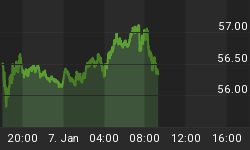Today's decision from China to raise the stamp tax on securities trading to 0.3% from 0.1% is a more direct attempt to cool its runaway stock market than last week's hike in reserve requirements and interest rates. The news was announced in early afternoon NY trade, causing a retreat in US stocks and the higher yielding pairs of EURJPY, GBPJPY, NZDJPY, NZDUSD and USDJPY. The explanation is that such increased transaction costs on equities would raise the likelihood of the much awaited "China correction", thereby triggering a repeat of the domino effect in global equities seen in late February-early March. China's benchmark Shanghai Composite Index is up over 65% year-to-date, reaching record highs over the last three sessions and closing at 4,334.92. Speculation is now reaching over to superstition as the Shanghai index approaches the much-feared figure of 4444-considered a very unlucky in China because it sounds like the word death in Mandarin. Last week, brokerage firms reportedly drove out investors seeking to sell some of their holdings.
The relevance for FX traders is that a pullback in Chinese equities would serve as a catalyst to a drying up of risk appetite and weigh on high yielding currency pairs mentioned above.
The week's busy trading schedule from the US calendar started off with a stronger than expected consumer confidence figure at 108 in May, which had a delayed impact in boosting the dollar. Wednesday's US figures will include the ADP report on private payrolls, expected to show a forecast of a 115K for April following the 64K in March. A figure at or above 100K would help support forecasts of a rebound in non-farm payrolls to 140-50K in April from the 88K in March. Such scenario is seen dollar supportive against the euro, sterling, Swiss franc and the yen as because an improved sentiment in US labor market would further reduce chances of Fed cut.
But the US currency continues to struggle against the Canadian dollar, hitting fresh 30-year lows at 1.0710 after the Bank of Canada expressed concern with rising inflation, stating that "some increase in the target rate for the overnight rate may be required in the near term to bring inflation back to the target". With the strengthening currency partly blamed for the loss of 250K jobs over the past 5 years by labor groups, The Bank of Canada faces the challenging task of tackling inflation at the expense of jobs erosion, particularly in manufacturing. Further gains in oil prices may force the BoC into a 25-bp rate hike to 4.50% this summer, but we expect the likely scenario to be an eventual retreat in inflationary pressures after the US slowdown extends to North of the border.
AUDCAD nears 11-month trend line support
Yes, we are still bearish AUDCAD after our calls on the pair on April 11 and May 03. Regardless of whether it will raise rates, the BoC has no choice but to maintain a hawkish stance on inflation, managing expectations if bond and traders in order to retain yields supported. This means that the Canadian dollar could continue to gather strength against the Aussie, Kiwi and even British pound. Considering this evening's Australian retail sales figures this evening, AUDCAD could come in under further pressure. The 9.30 pm EST release is expected to show a rise of 0.5% in April after a 1.1% rise in March. A figure of no more than 0.8% is likely to trigger further selling as the post-BoC bulls remain in control, targeting the 0.8715 target for week's end. The level coincides with the 11-month support and is just above the major foundation of 0.8657 -- the 61.8% retracement of the 0.8148--.9529 rally. We view any upmoves towards the 0.8860s as largely corrective in nature, with 0.8915 as medium term stop.

USDJPY displays ominous topping formation
Tuesday's unexpected data strength from Japan was a stark reminder for the yen bears focusing on the prolonged signs of deflation. The decline in the unemployment rate to 3.8% last month following 4 consecutive readings of 4%, and the 1.1% rise in household spending have helped stabilize worries of a retrenchment in consumer spending, and will provide a vital foundation to the overall economy, especially as consumption accounts for 2/3 of Japan's overall economy.
Despite widespread talk about the return of the carry trade, we stick with our reluctance to join the yen selling bandwagon, as the increasingly shaky foundation of world equity markets in technical terms raises the bar of outperformance and the risk of sharp correction. This is seen in the topping out pattern of the S&P500, DJIA and even the USDJPY rate. The looming negative crossover in the MACD and the bearish doji start pattern suggest the 120.85 to be a realistic target for this week, which is the 6-week trend line support. US data strength would deny this scenario in the short term, calling up 122.20, but we view the mounting systemic risks from an equity market correction such as a resulting from further Chinese policy measures as reasons to wave the red flag on USDJPY. An occurrence in the above fundamentals would also be detrimental to other high yielding pairs such as GBPJPY and NZDJPY. This would cause further declines in gold, until encountering our projected support of $635 per ounce.

















